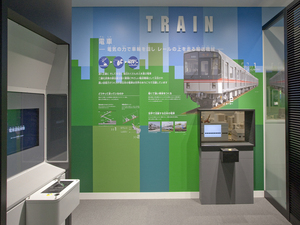Nagoya City Science Museum
TOP > Exhibition Guide > Keyword Search > Starting with "P" > pantograph > Train
Train



Purpose of Exhibition
Trains generate less CO2 compared with motorcars, and it is a transportation machine that can transport many people at a time.
Japanese trains, with their excellent safety record, have drawn the attention of the world. They have flourished throughout North America to South America, and southern Asia.
It has also been demonstrated as the best system by far to handle (by the minute) many wagons.
The purpose of the exhibit is to help you understand the technology of the train.
Additional Knowledge
[How a Train Runs]
The motor of a train rotates by means of electricity: this rotation is transmitted to the wheels, and the train moves on the rails.
[A Pantagraph Captures the Electricity]
A device called a pantagraph is used to capture the electricity from the lines installed above the tracks and on the tracks.
Even if the body of a train moves upward-and-downward, and rightward-and-leftward, it is constantly connected by spring force to the electric lines and electricity is supplied to the train.
A single-arm pantagraph is utilized with its neat and light shape.
In the case of bullet trains, an alternating current of 25,000 volts is supplied.
[Motors]
Motors are built-in within the framework of the train. Two gears, large and small, are attached to the axis of the motor. The gears engage together and the rotation power is transmitted to the wheels.
Earliest trains used direct-current motors. A rectifier to convert the current captured by the pantagraph from AC to DC was necessary. Because direct current motors wore out at the commutator and brush place, they had to be replaced frequently. Recently, AC motors are widely used.
[Light and Strong Bodies]
Modern trains made with stainless steel and aluminium compound metal instead of steel are light and are less likely to get rusty. A light body weight increases the energy efficiency, and CO2 emissions decrease.
[The Subway is a Train, too]
The subway is also a train. Most of its current is collected from the side of the track, but some have a pantagraph on the roof to collect current.
In the case of Nagoya Municipal Subway, examples of this system are the Tsurumai Line and the Meitetsu Line, which are interchangeable.
Cooperation:Nagoya City Transportation Bureau Nagoya Railroad Co., Ltd. Nippon Sharyo, Ltd.
Article by Koichi Mabuchi
